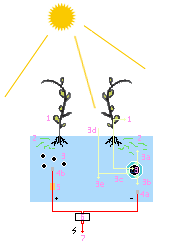No edit summary |
No edit summary |
||
| Line 2: | Line 2: | ||
[[File:Plant_Microbial_Fuel_Cell_setup.JPG|thumb|right|200px|A real-life plant-microbial fuel cell]] | [[File:Plant_Microbial_Fuel_Cell_setup.JPG|thumb|right|200px|A real-life plant-microbial fuel cell]] | ||
Microbial fuel | '''Microbial fuel cell'''s are a new way to generate electricity. They use the activity of bacteria to create a potential difference between two chambers. A wire that runs between these two chambers will have an electric current running along it. You can generate about 1kW from a cubic meter of dirt in this way. (The record is 2.3kW per cubic meter - think you can beat that?) | ||
Microbial fuel cells | Microbial fuel cells run on power generated by microbial activity in dirt, [[wastewater]] or other organic matter. There is a variant called a ''microbial desalination cell''. This takes saltwater, splits the salt into sodium and chlorine ions, and uses the potential difference between these ions to generate electric current. Create clean energy while [[desalination|desalinating]] water - how excellent is that? [http://www.gizmag.com/three-chambered-microbial-desalination-cells/12527/] | ||
Bio-electrical systems a microbial fuel cell use microbes to generate electricity. These microbes called exoelectrogens make contact with the electrodes thus generating electricity. Instead of using a catalyst that oxides the fuel with anodes and cathodes it uses living microbial catalysts which oxidize. This technology is great for cleaning wastewater and can be adapted for different applications. | Bio-electrical systems a microbial fuel cell use microbes to generate electricity. These microbes called exoelectrogens make contact with the electrodes thus generating electricity. Instead of using a catalyst that oxides the fuel with anodes and cathodes it uses living microbial catalysts which oxidize. This technology is great for cleaning wastewater and can be adapted for different applications. | ||
The electricity can be converted to other energy forms for storage (ie into nitrous oxide, oxyhydrogen, ...) | |||
In theory, you could build one into your [[compost]] heap and make that generate electricity, though there don't seem to be reports of people doing this. Someone '''must''' try this. | In theory, you could build one into your [[compost]] heap and make that generate electricity, though there don't seem to be reports of people doing this. Someone '''must''' try this. | ||
| Line 17: | Line 19: | ||
==External links== | ==External links== | ||
*[http://en.wikipedia.org/wiki/File:SoilMFC.png Soil-MFC system] | * [[wikipedia:Microbial fuel cell]] | ||
* [http://en.wikipedia.org/wiki/File:SoilMFC.png Soil-MFC system] | |||
[[Category: Energy]] | [[Category: Energy]] | ||
Revision as of 12:24, 4 January 2013


Microbial fuel cells are a new way to generate electricity. They use the activity of bacteria to create a potential difference between two chambers. A wire that runs between these two chambers will have an electric current running along it. You can generate about 1kW from a cubic meter of dirt in this way. (The record is 2.3kW per cubic meter - think you can beat that?)
Microbial fuel cells run on power generated by microbial activity in dirt, wastewater or other organic matter. There is a variant called a microbial desalination cell. This takes saltwater, splits the salt into sodium and chlorine ions, and uses the potential difference between these ions to generate electric current. Create clean energy while desalinating water - how excellent is that? [1]
Bio-electrical systems a microbial fuel cell use microbes to generate electricity. These microbes called exoelectrogens make contact with the electrodes thus generating electricity. Instead of using a catalyst that oxides the fuel with anodes and cathodes it uses living microbial catalysts which oxidize. This technology is great for cleaning wastewater and can be adapted for different applications.
The electricity can be converted to other energy forms for storage (ie into nitrous oxide, oxyhydrogen, ...)
In theory, you could build one into your compost heap and make that generate electricity, though there don't seem to be reports of people doing this. Someone must try this.
Instructions on building your own
- http://www.microbialfuelcell.org/www/index.php/Tutorials/
- Instructables Part 1, Part 2 and Part 3.
- Six part YouTube tutorial
- You definitely need to watch this lecture by Bruce Logan. It gives a bunch of tips on how to maximise power production from your microbial fuel cell and also explains how to make microbial electrolysis cells and microbial desalination cells. It condenses several years of research into an hour.